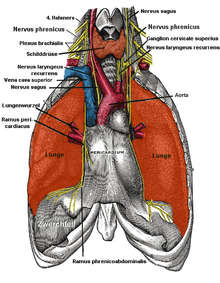Phrenic nerve
The phrenic nerve (diaphragmatic nerve ) is a nerve that arises from the neck area of the spinal cord and, among other things, innervates the diaphragm .
In humans, the nerve arises from the 3rd to 5th neck segment of the spinal cord and is a branch of the cervical plexus , in one fifth of individuals there are additional accessory phrenics ( Nervi phrenici accessorii ) from the lower neck segments. The phrenic nerve runs in front of the anterior scalene muscle and behind the deep cervical fascia as well as the sternocleidomastoid muscle , and then, accompanied by the subclavian artery and vein , enters the upper thoracic aperture. There it is initially in front of the pleural dome and then between the mediastinal pleuraand the pericardium to get to the diaphragm. It is accompanied by the pericardiacophrenic artery . On its way it gives off branches to the pericardium, the mediastinal pleura and in the abdomen to the peritoneum of the liver , pancreas and the anterior abdominal wall. If the pericardium is opened, the nerve can be damaged. In a pleurisy (pleurisy) can cause irritation of the nerve and thus to a hiccup ( hiccough come).
Phrenic paralysis (phrenic nerve palsy)

In a paralysis of the phrenic nerve relaxed on the relevant page of the diaphragm , that is, there is a diaphragmatic paralysis ( diaphragm paresis ). Since the abdominal organs are normally pressed down by the diaphragm, they press up when the diaphragm relaxes. A so-called elevated diaphragm arises . A one-sided elevated diaphragm is associated with severe breathing difficulties , but is usually survived. A bilateral failure of the phrenic nerve, on the other hand, is life-threatening.
Due to its early exit from the vertebral canal , humans still have the possibility of breathing through the diaphragm even with paraplegia in the area of the rear cervical spine . Basically, with a deformation up to the third cervical vertebra, massive disturbances of the function of the lungs and heart are to be expected with a high probability, with damage to the fourth cervical vertebra probable. From the fifth cervical vertebra, life-threatening paralysis symptoms are no longer common, but spinal cord injury symptoms such as a dysfunction of the extremities and others are common.
Phrenic irritation
After gas-containing laparoscopy , irritation of the phrenic nerve often occurs in patients, which manifests itself in chest or shoulder pain. The gas used puts pressure on the diaphragm, causing nerve irritation. After the residual gas has completely escaped after the laparoscopy, the symptoms disappear.
Magnetic stimulation
For diagnostic purposes, the phrenic nerve can also be stimulated using magnetic induction. Although this is much gentler than electrical impulses, there is no product on the market that uses this method.
literature
- Martin Trepel: Neuroanatomy. Structure and function. 3rd, revised edition. Urban & Fischer, Munich et al. 2004, ISBN 3-437-41297-3 .
- Franz-Viktor Salomon: nervous system, systema nervosum. In: Franz-Viktor Salomon, Hans Geyer, Uwe Gille (Ed.): Anatomy for veterinary medicine. Enke, Stuttgart 2004, ISBN 3-8304-1007-7 , pp. 464-577.
Individual evidence
- ↑ Paul Phelps: In Patients Undergoing Gynecologic Laparoscopy ... Simple Pulmonary Maneuver Relieves Shoulder Pain. In: Anesthesiology News. 35, 2009, p. 9. (online)
- ^ F. Laghi, MJ Harrison, MJ Tobin: Comparison of magnetic and electrical phrenic nerve stimulation in assessment of diaphragmatic contractility. In: J Appl Physiol . 80, 1996, pp. 1731-1742.
- ↑ T. Similowski, B. Fleury, S. Launois, HP Cathala, P. Bouche, JP Derenne: Cervical magnetic stimulation: a new painless method for bilateral phrenic nerve stimulation in conscious humans. In: J Appl Physiol. 67, 1989, pp. 1311-1318.
- ↑ CH Hamnegåard, S. Wragg, D. Kyroussis, G. Mills, B. Bake, M. Green, J. Moxham: Mouth pressure in response to magnetic stimulation of the phrenic nerves. In: Thorax. 50, 1995, pp. 620-624.
